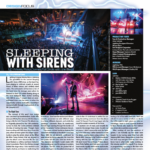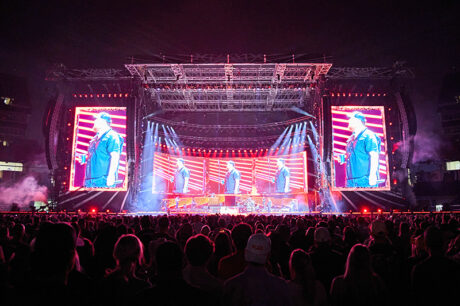
This summer, Country music superstar, Luke Combs played stadiums throughout the U.S. on his World Tour. before playing Australia and New Zealand, then on to Europe. Handling lighting for the tour is Production Designer Oli Metcalfe and five year Combs veteran, Lighting Director, Kevin Northrup. Both took time before the tour headed down under speak with PLSN about casting more than just a spotlight on this multi-award-winning artist.
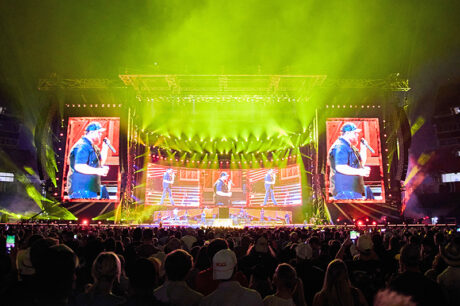
Oli Metcalfe
Production Designer
Tell us about your approach to the design, as well as the use of color to support the music.
In terms of color, I was aligned with Kevin. When I sent my initial deck, he responded, ‘Yeah, that song is that color. That works great.’ I found the palette based on listening repeatedly to Luke’s music and going, ‘Well, actually, a lot of it needs to just be nice, big, bold sepias, whites, or big rock colors.’ Then some of it was too blue and I was like, ‘No, we need to get away from blue.’ That’s probably when I asked, ‘Why don’t we just have white? Why can’t we just have more white—more warm white and cold white?’ I would’ve just been more bold and less saturated if I could. If there was a choice to make a change to it now, I’d be more white and one saturated color. I found some of the color tones to be bold, and it was quite striking.
Overall, for the approach to the design, we were able to work together to design something that’s so efficient. After Covid, it’s kind of the new design remit for everyone. The designs I’m doing now are basically much more driven towards the artist being able to take more of a risk in what they’re doing from a show perspective, rather than what they want to spend financially on their production. At the end of the day, it’s all about being able to give the artist a space where they can be happy and do a great show for their audience. The lighting and visuals are another elevation to that. There’s so many tools, toys, and trinkets that we now have accessible to us that it’s more a case of just laying those out in a way that you’re comfortable with delivering a palette and a picture that you can paint for the artist. Then be able to package it in a way that fits into an efficient amount of truck space and an efficient amount of touring crew. Then it becomes a machine that’s an operable business, that doesn’t hobble along. This tour fits into literally three lighting trucks and is a well-oiled machine.
The tour wanted to spend very little in terms of custom fabrication. So, I worked with a structure that already existed, with a G2 100’ wide stage. The thrust was already an entity that Jerry [Slone, PM] had worked out with Luke, so I just re-engineered that and did all the CAD drawings for it. It was an easy thing for me to work with Jerry on the design. Jerry was super cool the whole way through the process and dealing with all the stage artwork. Ty Trussell, over at Gallagher, got him aligned with an artist who did all the floor painting. And then Jerry also has a good relationship with SES and they worked with us on getting what we needed for the design.
I know you’re a fan of Ayrton products. Talk about their use on this tour.
I’ve been working in Europe with Ayrton fixtures for longer than they’ve been in the U.S., and I know that Chris Ferrante and the U.S. Ayrton team have really pushed them forward.
What I love most about the Ayrton product is its physical characteristics. Also, if you took a Perseo and a Domino and hung them on the same chord of truss, when you tilt them forward—because of the yoke and the distance from the base to the pivot point on the yoke—they all level out as one linear run of lights. That’s something that Ayrton had obviously considered in their designs of the lights from the outset.
The other thing I like about the Ayrton lights is the beam effects, the ultra-rapid zoom and iris, the way that they index their gobo so precisely that you can actually play with the index values on a flat beam, and they’ll all be vertical, for example. That’s just quality control. The consistency through the fixtures in big numbers is so unified that it’s enjoyable to work with them.
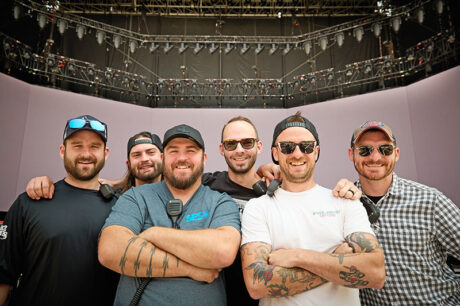
Your lighting supplier was SES, as you mentioned, how was their support?
It was my first time working with those guys, and that was really exciting. They delivered much beyond my expectations, to be honest. It was a very well put together package from SES. Michael Brammer gave me everything I wanted. I was a little bit apprehensive about specifying so many Ayrton fixtures initially, without knowing SES, and it turned out to be the perfect fit, because SES invested a ton of money literally at the beginning of this year in changing out much of their inventory to Ayrton. They delivered exactly on point what I was hoping to use, which was a fully IP rated lighting package. That was so we could go into conditions where the weather may have been a little bit unfriendly.
I couldn’t fault anything that SES put forward as their package. It was nicely trucked and nicely presented, and Justin [Duguid], the Lighting Crew Chief, was amazing, Josh [Cox], the FollowMe Engineer got the FollowMe happening just how I wanted it to work. It was really an enjoyable experience.
Talk about working with the Production Manager, Jerry Slone.
Jerry is fantastic.
I love Jerry Slone for bringing me into the Luke Combs family, which is very well-established. He reached out to me cold; we’d never worked together before, and he reached out, saying, ‘Hey, Luke’s looking for a new design. He’s seen some of your stadium work and likes what you do—the big bold looks, that don’t march all over the music.’ So, he gave me a remit that stuck until we delivered. He never faltered, never changed it. We kept with our plan and delivered it. I think my design came through in the end for Jerry because I was fully able to work to his parameters of, ‘We aren’t spending a million dollars, son!’ Super respect to Jerry; I can’t wait to work with him again.
And this is also your first time working with Kevin Northrup, correct?
It was a bit of a baptism of fire, particularly in the outset, as there were some issues in getting my visa sorted. I turned up quite late to rehearsals, which put a little bit of unnecessary pressure on Kevin, but he stepped right up to the plate. I baptized him with fire, primarily, forcing him into going to [grand]MA3, which I’ve been using quite considerably on a number of tours. Kevin fully embraced that and continues to this day to enjoy working with MA3, I believe.
As I said, the Luke Combs family having been together for a number of years. So, Jerry was very keen to keep the foundation of that family complete. Fortunately for me that meant Kevin was the lighting director and that led to a good collaboration. Kevin knows where the cues are since he had done designs for Luke on things before this tour. I respect him immensely for how he worked with me and handled someone new coming onto the tour. He evolved all the dynamic cues that he knew in the show into this design, and that worked really well. That’s why we ended up getting on so well.
Any other thoughts on lighting for Luke Combs?
It was fun, and interesting to do something different, I haven’t really done a country music act before. Also coming into a well-established team like is on Luke Combs can be difficult but everyone was really welcoming in and supportive.
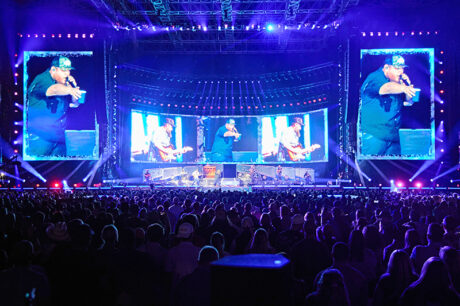
Kevin Northrup
Lighting Director
Talk about the lighting on this tour and working with Oli Metcalfe.
This design is a different direction than what we previously did. So, it’s mainly figuring out how to massage the aesthetic to fit Luke. It’s always about that, honestly, no matter what rig we use. I try to be flexible with the programming and with the aesthetic and not get too locked in. Luke has been very trusting over the past five years. Because it’s country music, we don’t do rainbow chases; that seems way too poppy. But pretty much anything else is on the table—except red and green. It isn’t a Christmas show, so we don’t use red and green together.
Working with Oli was good. He was new to the tour and appreciated that I was there for a while, and I really understood Luke’s aesthetic. He basically just let me run with the programming. He set up the file and got the bones of the show in there and said, ‘You know Luke’s music, you know his look; make it look like a Luke show.’ So, I did.
Talk about some of the key gear choices and how they supported the design.
I love the Domino LTs. The thing that I’ve noticed about all the Ayrton gear is that the optics are stunning. Obviously, the Domino LT has insane optics because it’s a long throw fixture, but even down to the Khamsin or the Zonda, which are surprising. During focus in Philadelphia, they have a big scoreboard at the other end of the field. I was able to get a perfectly crisp circle from a Khamsin at like 500’. Another compliment I give to the Ayrton gear is the gobo selection, and how uniform it’s across its entire fixture range. Most of the fixtures share several of the same things, one of which is they are easy to program.
The choice of Ayrton also worked well because we knew we wanted to go with SES as the vendor, and they’ve been transitioning to being a mostly Ayrton house. They’re big fans of that gear, and so are we. That let us keep within the inventory of a vendor that we like and not blow the budget out of the water. We could have specified pretty much anything, but we have to live in the real world where budgets do matter. The best way to economize on a budget and extend your reach with your design is to use the fixtures that are in inventory, or things that vendors are excited to buy, which seems to be the case with Ayrton across our industry.
What are you using for strobes?
We have some [GLP] JDC Lines upstage center on the set pieces, but I treat every light as if it can strobe. The JDC Lines have been a nice architectural element in the design that really kind of ties the flown rig portion to the stage portion.
How do you like the Follow-Me system for remote followspots?
I love it. I’ve been touring with it since 2019 and they’ve made some good updates. The biggest benefit is the fact that we’re actually using a robotic system, which really increases the consistency of the show because our touring techs operate it. I have one FollowMe Engineer [Josh Cox] who oversees the entire system and two techs that run it every show. In terms of positions and locations, I give them a set list with band members’ names on it for each song. They know who those band members are because they’ve been working with this tour for a few years now. So, instead of me having to call the spot, number by individual number, and give them a very specific target, I can just say ‘Spot three, go’ or ‘All spots, go.’ So, it takes a lot less effort to run spots for a show that way. There’s a lot more that we could do with that software, but we try to keep it simple. I pretend they’re basically standard Super Trouper units; they just happen to be remotely operated. I don’t control much from the desk—just the color correction; the operators control pan, tilt, iris, and dimmer.
How was working with SES and their support for the tour?
SES has never let me down. They provide great quality gear and some of the best touring techs that I know of, maybe even the best in the world, as far as I’m concerned. The support has been amazing. We’ve never been waiting for any gear to be replaced, and they take gear issues very seriously; following up many times until the issues are resolved. I usually hear from multiple people in the company; not only Michael, but also the Lighting Department Manager just to make sure I’m covered, which is great. I’m not sure if that’s normal; this is the first tour I’ve done at the stadium level, but it definitely feels good to be supported in the way that they do.
Tell me about your lighting crew that you’ve got on this one.
I have six guys on the crew, and they’re led by a great guy named Justin Duguid, our lighting crew chief. He’s picked a great crew from SES. He leads them very effectively, which is not a surprise to me. In fact, Justin was the guy when we first started taking a rig out in 2019, SES asked me, ‘Okay, who do you want as your crew chief?’ I wanted Justin. I know that Justin will always give me a working lighting rig. No matter what has happened in the day, I know with him on my team, I can focus on the programming and not worry about the rig itself. In the four years we’ve been working together, he’s never let me down. We have a great comradery on the crew; it’s a good vibe and I’m immensely grateful for every single one of the guys that are on the lighting team. Without them, I couldn’t do what I do.
You have worked with Jerry Slone, the Production Manager, for a while on Luke Combs.
I love working with Jerry. He’s the lowest stress Production Manager I’ve ever worked with. I’ve never seen him get mad. I’ve never seen him yell. I’ve never seen him rage fire at anybody. In fact, quite the opposite. He’s a very calming presence on the tour and a very grounding element for those days that aren’t going well. If you’re feeling frustrated, you could go up to him and vent some of those frustrations. He’ll look at you, smile and be like, ‘It’s okay. We’re not saving lives out here. We’re supporting someone who plays a guitar for people.’ It really helps ground you—your expectations, and your stress. He always just gives us the tools that we need to do what we do and doesn’t micromanage. He’s an amazing guy to work with. I’m just immensely happy to be a part of the Luke Combs tour and that I get to make cool things happen every show.
